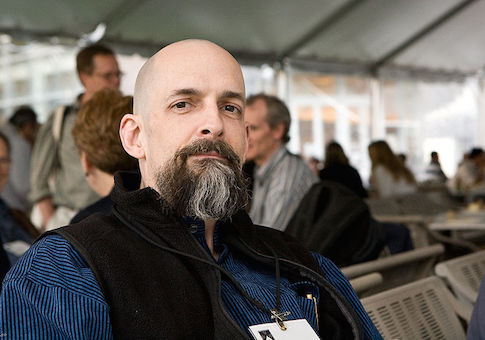The typical science fiction writer will take a concept he finds interesting—say, nanotechnology—explore and build an architecture of plot around the theme and if it all goes well something entertaining will be the end product. Not so with Neal Stephenson. Everything he has written is a heady mix of half a dozen complex ideas: cryptography, currency, philosophy, the history of science, memetics, computer viruses, and so on. (Stephenson brought our present meaning for the word "avatar" into common usage.) If he weren’t often seen in public, it would be possible to argue that Stephenson was some sort of composite, a synthesis of assorted futurists, historians, philosophers, and fiction writers, all writing as a team.
Stephenson’s latest book, Seveneves, is in the same mold as he previous works, but continues a late-career trend toward accessibility that began with his techno-thriller Reamde. Gone are the typical Stephenson-esque digressions, the postmodern flourishes, pre-chapter dictionary entries, and neo-Victorian novelistic conceits. Instead, Seveneves delivers a classic science fiction disaster story. The first sentence is, "The Moon blew up without warning and for no apparent reason." A few pages later we find out that a wandering black hole has destroyed Earth’s satellite. The remaining rocks form a cloud of space junk whose stability is deteriorating exponentially. Within two years a lethal meteor shower will scour Earth’s surface of all life. World leaders, helped along by one of the main protagonists, a public figure on the order of Neil Degrasse-Tyson (without the tedious mendacity and condescension of the real-life version), decide that the planet’s genetic heritage and the human race’s best chance of survival is to create a durable habitat out of the International Space Station.
All this occurs in the very near future, with similar technology to the present-day, meaning that only a tiny fraction of humanity’s population will be able to make it into space. The remaining 99.9 percent of the population will be incinerated when the moon rocks fall, giving the overwhelming majority of humanity near-exact foreknowledge of their death. Stephenson ably details the human cost of this psychological body-blow. Readers will, for the most part, realize that there is no way that, in the event the moon explodes, they will be chosen to go into space and represent humanity. It’s a humbling and thought-provoking realization.
Stephenson’s prose is quietly impressive, managing to fit in a staggering amount of technical detail without letting the story collapse under the pressure. That said, there is plenty of technical exposition—too much, in some passages. The author is fascinated by the physics of chains in motion (along with a host of other, more obscure technological nooks and crannies) and eager to tell us about it. Whether readers will find this interesting depends on them. This is an inevitable pitfall of "hard," or technology-centered, science fiction that the Stephenson does not quite avoid.
Seveneves also suffers from the techno-libertarianism of Stevenson’s Silicon Valley social milieu. This ideology elevates meritocracy to theological proportions. The novel seems to suggest that, if only the tiresomely average-to-above-average people could be jettisoned, then the truly exemplary, the technocrats and engineers, could take humanity to the stars.
That is not to suggest that this novel isn’t entertaining—it is, massively so. It just carries with it a higher-than-usual dose of Stephenson’s preoccupations, while being borne aloft on a similar dose of his usual strengths. Seveneves is the product of a unique intelligence, and of a writer in the prime of his career.
